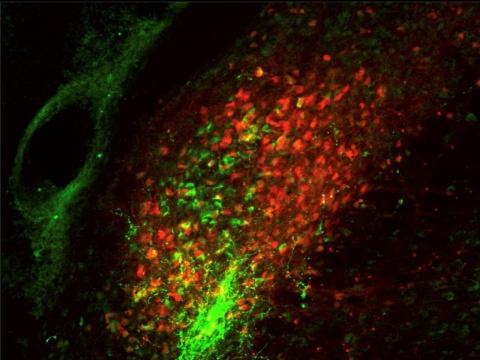
Members of the Duke Neurology Department contributed to 13 new peer-reviewed journal articles in January 2021. Daniel Laskowitz, MD, MHS, co-authored two studies examining the complications of traumatic brain injury. A team including Andrew Spector, MD, wrote a “road map” for how neurology departments can create effective diversity officers. Our faculty, trainees, and research staff also examined possible treatment candidates for ALS, identified new risk factors for stroke, and genetically engineered cartilage to produce its own anti-inflammatory drug. Read about these studies and more in the paragraphs below.
Translational Brain Sciences
- Senior author Michael Lutz, PhD, Carol Colton, PhD, W. Kirby Gottschalk, PhD, and Alexandra Badea, PhD, developed a method to test for age and sex interactions with protein expression levels in Alzheimer’s and compared pathway results between human and mouse species. Their method highlights similarities and differences between human Alzheimer’s and mouse models, allowing for improved models in the future. Read that article here.
- A new study answers important questions about how the visual or semantic presentation of an object affects subsequent memory. First author Simon Davis, Mariam Hovhannisyan, and colleagues at the Duke Cognitive Center for Neuroscience used fMRI to identify brain regions where each representation type predicted later perceptual memory, conceptual memory, or both. Read the full study in Cerebral Cortex.
- Another study by a similar team published in Memory & Cognition also examined how visual and semantic features predict object memory. Lead authors Davis and Hovhannisyan and colleagues conducted a memory study examining how visual and semantic factors contribute to object memory, true and false memory performance and other factors. Their findings help to provide a more complete picture of what factors influence object memorability. Read more about them here.
Neurocritical Care
- A new review article examines the epidemiology, mechanisms, and clinical management of multi-organ dysfunction following severe traumatic brain injury. Daniel Laskowitz, MD, MHS, contributed to the article which appears in Chest. Read it here.
- Daniel Laskowitz, MD, MHS, and Michael “Luke” James, MD, contributed to a new Neurocritical Carearticle examining the association of severe acute kidney injury with mortality and healthcare use after isolated traumatic brain injury. Read that article here.
Diversity and Inclusion
- Academic Neurology Departments must confront the challenges of developing a diverse workforce, reducing inequity and discrimination within academia, and providing neurologic care for an increasingly diverse society. A team including Andrew Spector, MD, laid out a roadmap for developing an effective diversity officer that can meet these urgent needs. Read more about these roles and duties in the latest issue of Neurology.
Stroke and Vascular Neurology
- Stroke is a devastating complication of left ventricular assist device (LVAD) therapy. Senior authors Nada El Husseini, MD, and Ovais Inamullah, MD, as well as Martin Weiss, MD, Michael Lutz, MD, Wayne Feng, MD, MS, Matthew Leudke, MD, and colleagues performed a retrospective cohort study of nearly 250 patients with LVAD who had a stroke, examining the types and severity of stroke in this population. Read what they found in Scientific Reports.
- Michael Lutz, PhD, Christian Hernandez, MD, Jennifer Kang, MD, and medical student Safa Kaleem developed a triage model to identify patients who can safely avoid transfer to a comprehensive stroke center. Their analysis suggests that spontaneous intracerebral hemorrhage patients with Glasgow Coma Scale >13, intracerebral hemorrhage volume <15 ml, absence of intraventricular hemorrhage, and supratentorial location might safely avoid inter-hospital transfer to a comprehensive stroke center. Read their full study in the Journal of Strokes and Cerebrovascular Disease.
- A study in Translational Stroke Research identified a new risk factor for stroke: the left atrial septal pouch. This pouch, essentially an open flap in the inter-atrial septum was associated with cryptogenic stroke in an analysis of more than 300 transesophageal echocardiograms performed by resident Lara Wadi, MD and colleagues. Read the full study here.
Neuromuscular Disease
- Neuromuscular ultrasound is a rapidly evolving specialty with direct application for patient care. Lisa Hobson-Webb, MD, contributed to a Muscle and Nerve article that built a general framework for neuromuscular ultrasound competency assessment and recommended testable areas of knowledge and skills suitable for establishing minimal competency. Read that article here.
- Rick Bedlack, MD, PhD, was the first author of the 59th entry in the ALSUntangled series of investigations reviewing alternative therapies as candidates for ALS treatments. Their review of tamoxifen found that it has plausible mechanisms, a positive preclinical study, a case report and 2 small trials suggesting benefits. Jesse Crayle also contributed to the study, which appears in Amyotrophic Lateral Sclerosis and Frontotemporal Degeneration.
Other Topics
- A team including Wolfgang Liedtke, MD, PhD, were able to genetically engineer cartilage to deliver an anti-inflammatory drug in response to activity similar to the bending of a knee or other motions that put stress on joints. By altering genes in cartilage cells in the laboratory, Liedtke and colleagues at the Washington University School of Medicine in St. Louis were able to program them to respond to the mechanical stress associated with movement and weight-bearing by producing a drug to combat inflammation. Read the full story in Science Advances.
- The Duke Center for Neurodiagnostics and Neurotherapeutics’ Anne West, PhD, was the senior author of a new commentary article in Cell Calcium discussing a novel interaction between NMDA-type glutamate receptors and TRPM4 that is required for NMDAR-induced neuronal death. Read that article here.